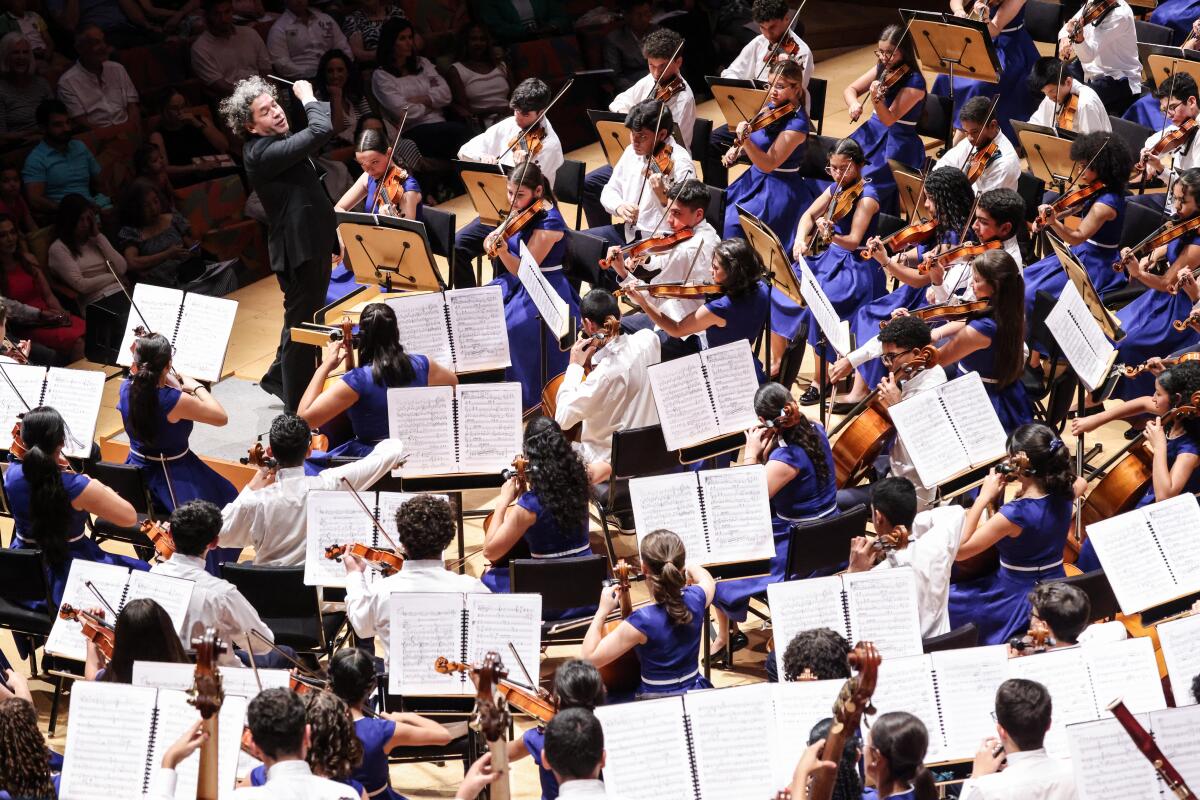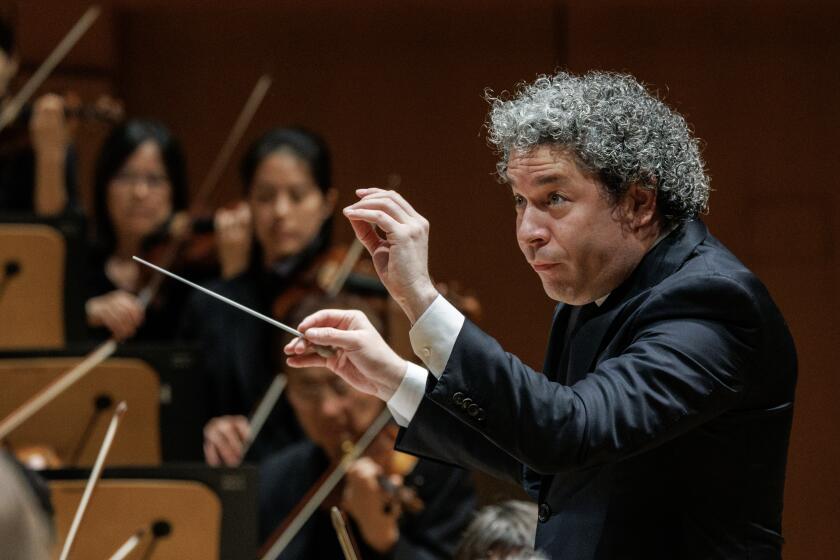Commentary: In a divided Venezuela, National Children’s Symphony, with Dudamel’s help, shows how to get along

- Share via
Imagine a television station’s simultaneous live broadcast from downtown Caracas, Venezuela, and downtown L.A. on Monday night.
On one side of a split screen is an inferno. Outraged Venezuelans are protesting Sunday’s contested election in the capital, setting automobile tires on fire. Violence breaks out between supporters of President Nicolás Maduro and his angry opposition.
On the other side, jubilant Venezuelans jump for joy on the stage of Walt Disney Concert Hall. An exultant audience lets out ear-splitting screams. A woman in the crowd proudly unveils a large Venezuelan flag.
With the Los Angeles Rams and Chargers’ forthcoming stadium certain to transform Inglewood, a $14.5-million renovation of an abandoned bank building a mile away may seem a smaller emblem of civic renewal.
The Disney jubilation was for the National Children’s Symphony of Venezuela conducted by Gustavo Dudamel on the first leg of a U.S. tour. This stupefyingly great orchestra of young musicians between the ages of 10 and 17, who need to be seen and heard to be believed, were participants in “Citizens of the World: An International Youth Festival,” sponsored by the Los Angeles Philharmonic as part of its Youth Orchestra Los Angeles (YOLA) program.
But the stupefyingly great orchestra also happens to be a showcase for Venezuela’s famed countrywide music education program El Sistema, which is funded by, and can serve as a propaganda tool for, Maduro’s government. Given the crises in Venezuela — horrendous violence, spectacular economic downturn, suppression of opposition — in the president’s two terms, this tour has raised red Venezuelan flags from the likes of noted pianist Gabriela Montero, who grew up with El Sistema and performed with Dudamel in her youth before leaving the country.
While every Venezuelan president, populist or elitist, since 1976 has sponsored El Sistema and blatantly used it as propaganda, Montero has become an eloquent dissident against the authoritarian Maduro’s doing so. In a public letter, she’s asked her “fellow musicians” to help her protest the “massive injustice to stop our classical music industry from laundering and profiting from my nation’s continuing, abject misery.”
Dudamel and the children’s orchestra follow Monday’s Disney concert with high-profile appearances at Carnegie Hall in New York, the Chicago Symphony’s summer home at Ravinia in Highland Park, Ill., and the Boston Symphony’s summer home at Tanglewood in western Massachusetts.
We listen in on the first acoustical test of the new Beckmen YOLA Center in Inglewood, which promises to be revolutionary.
However principled Montero’s protest may be, she and her family have, along with millions of others, personally suffered from Venezuela’s situation. But Monday’s concert told another story. For one thing, there was no economic profiting — tickets were free. As for propaganda, well, I was there and I’m writing this, but the event attracted little press otherwise. You could request tickets on the L.A. Phil website, but the orchestra didn’t promote it.
The concert was simply part of what the L.A. Phil called YOLA National Festival, its gathering of youth orchestras from around the country to participate in workshops at its Beckmen YOLA Center in Inglewood, in which the Venezuelan children also participated. This culminated in a concert at Disney Hall on Sunday evening with YOLA National Overture Orchestra (players ages 12 to 14) and Symphony Orchestra (musicians 14 to 18). Venezuelan kids joined in with both YOLA bands, as did the YOLA kids on Monday with the National Children’s Symphony. It was easy to forget how young these players were or how little time they had together in their varied pieces conducted by Dudamel and two younger conductors (Kalena Bovell and José Ángel Salazar).
The National Children’s Symphony is a somewhat younger version of the erstwhile Simón Bolívar Youth Orchestra of Venezuela that Dudamel first brought to Disney in 2007, when it seemed to be the greatest orchestra show on Earth. Those players were mostly in their early 20s, although some were as young as 12. The Bolívars have now aged into a professional orchestra and Dudamel, who grew up with them, has remained their music director despite political ups and downs that made him for some years unwelcome with the Maduro administration. He’s been going back to Caracas regularly the past couple of years and will tour with the Bolívars in Europe early next year.
Like the old Bolívars, the Children’s Symphony is big, with about 180 musicians. The members sit close together and play with the physical synchronicity of trained dancers. Their sound is too exhilarating for mere listening. You somehow feel as though you, too, are a participant in the sheer muscularity of it all.
The first half of the program was L.A.-centric, beginning with John Adams’ “Short Ride in a Fast Machine” and ending with John Williams’ “Olympic Fanfare and Theme.” Both works were given by Michael Tilson Thomas, and the latter was commissioned by the L.A. Phil for the 1984 Summer Olympics in L.A. The fanfare, enhanced by brass from YOLA National Festival, created a kind of excitement that the two orchestras at Paris’ Olympics opening ceremony (at least as they came across on the godawful television broadcast) could not come close to matching.
After three months away, Dudamel is back for a month to revive ‘Fidelio’ and oversee his Pan-American Music Initiative. But then he’ll be gone again until end of August.
The big work was Shostakovich’s Fifth Symphony. From the moment of its triumphant 1937 premiere in Leningrad, the heroic symphony has been laden with political baggage that is not likely to be unnoticed on the Children’s Symphony tour. In hot water with Stalin for his more modernist music, with its gloom-and-doom sarcasm, the Russian composer needed a helping of straightforward Soviet glorification. Shostakovich’s detractors have accused him of ennobling Stalin while defenders have sought out subtle musical cues of dissent.
Shostakovich said only that the symphony was, in the Beethovenian manner, an overcoming of tragedy. Indeed, the glorification may well have been of the composer himself. With a huge orchestral machine powered by limitless quantities of adrenaline, Dudamel needed only to take Shostakovich at his word, and glorify the orchestra that he may love more than any other. Every time I have met with him over the past few years, the first thing he has done is show me clips of the kids playing.
If we are to read anything into the great performance, stunning in its attention to detail and its overwhelming power, it was a demonstration of the lives of nearly 200 young people who have lived through hard times. Young people in a divided country who every day rehearse with and befriend kids different than they are, richer or poorer, right-wing or left, seeing how the other half lives. Together they work to make a difference.
But has that made Venezuela better? There’s no evidence it has. But the kids are better off and on Monday they were inspiring messengers of hope running eternal. In L.A., they were given the opportunity to meet and befriend Americans and to rehearse and perform in the best acoustics in the world. The rest of the tour will be more formal concerts for paying audiences. Carnegie tickets are being scalped for as much as $850. There will be no YOLA kids joining in and cheering them on, no Olympic fanfare.
The Children’s Symphony has added something new and radical: sheer chaos to “Mambo” from “West Side Story.” The Bolívars made that their trademark encore, twirling instruments and jumping up and down. But in L.A., the kids began running around the stage in wild merriment, still playing, still on the beat. Dudamel grabbed a violin and joined in.
That became the ultimate message. The world is a mess. Their country is a mess, seemingly entering yet again into a crisis with the contested election. But they play on and play together with a common goal. The trick, though, is to get the governing bodies to pay attention to their own propaganda.
More to Read
The biggest entertainment stories
Get our big stories about Hollywood, film, television, music, arts, culture and more right in your inbox as soon as they publish.
You may occasionally receive promotional content from the Los Angeles Times.













